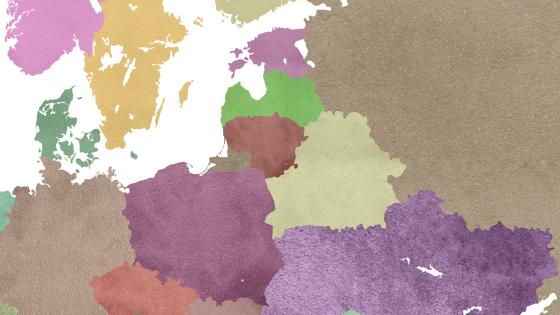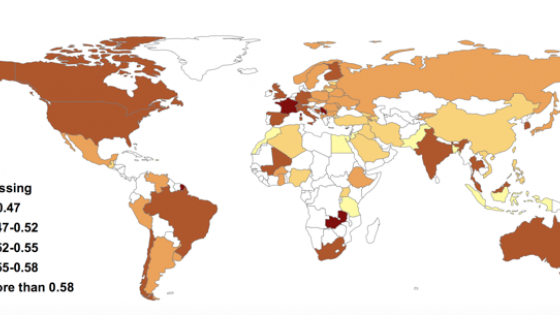Tragically, a war over borders is again at the centre of Europe. As Ukraine fights against Russia’s invasion, historical events going back to the creation and breakup of the Soviet Union continue to affect the geopolitical debate. Right before the invasion last February, Russian President Vladimir Putin (2022) said that “Lenin’s ideas [of a] confederate state arrangement and a slogan about the rights of nations to self-determination, up to secession, were laid in the foundation of Soviet statehood,” and asked “Why was it necessary […] to satisfy the ceaselessly growing ambitions on the outskirts of the former empire? Why transferring to the newly, often arbitrary formed […] union republics vast territories that had nothing to do with them?”
A new study by Castañeda Dower et al. (2022) provides a possible answer to Putin’s rhetorical question. The authors find that, contrary to Putin’s claim, the Soviet rulers did not create their republics ‘arbitrarily’ but designed them (almost) ‘optimally’, aggregating groups to minimise ethnic segregation within each newly formed republic, subject to minimum-size constraints related to economies of scale. They also find that this strategy of taking ethnic and linguistic heterogeneity into account when drawing borders paid off in the early period of the Soviet state, by reducing ethnic conflict and improving relative socioeconomic conditions in the Asian republics.
In this respect, the Bolsheviks behaved differently from colonial powers in Africa, where borders were often drawn artificially, splitting existing ethnic groups and ignoring the social arrangements of the people on the ground, with negative long-term consequences for peace and development, as shown by Michalopoulos and Papaioannou (2016, 2017).
Studies like those by Michalopoulos and Papaioannou and by Castañeda Dower et al. contribute to a growing literature that uses the theoretical and empirical tools of economics to understand the determinants and effects of political borders and conflict. Recent contributions also include, for instance, Allen (2022), Esteban et al. (2022), and Fernández-Villaverde et al. (2023), among many others.
This line of research goes back a few decades, as it was partly motivated by the breakups of the Soviet Union, Yugoslavia, and Czechoslovakia in the 1990s, and the creation of independent states in Africa and Asia in the post-colonial period. In a recent paper (Spolaore 2022), I provide a new overview and discussion of this literature. The overview, on which this column is based, is dedicated to the memory of Alberto Alesina, a founder of contemporary political economy and a pioneering contributor to the economic study of borders and related areas, including the political economy of ethnic diversity and the interplay between culture and institutions.
In fact, cultural and political factors are crucial for the economic analysis of borders, because they, along with economic forces, affect the trade-off between benefits from size and the costs associated with different preferences over public goods and policies (Alesina and Spolaore 1997, 2003).
In general, cultural heterogeneity comes with both costs and benefits. More diversity of viewpoints and preferences can provide large societal benefits through specialisation, innovation, and exchange. For example, a society with more diverse tastes in private consumption or regarding when to work is likely to be more efficient and harmonious than a society where everyone wants to consume the same goods, live in the same locations, and enjoy leisure at the same times. However, more diverse preferences over public goods are harder to reconcile because those goods are nonrival: everyone within the borders must share the same government, laws, and policies. While this is a source of economies of scale, it can also cause conflict, therefore generating a trade-off between benefits from size and heterogeneity costs.
The empirical evidence is generally consistent with more cultural heterogeneity going together with lower provision of public good, more civil conflict, and a higher chance of breakups. Moreover, the fact that heterogeneity within borders creates costs to governments that must provide the same public goods to all can explain why expansionist rulers have often tried to conquer regions which they perceived as culturally closer to their own core, in the expectation that the occupation of those regions would come with lower political costs and higher rents for themselves. Then, paradoxically, we observe that sovereign states that are more closely related along cultural and historical dimensions are also more likely to fight with each other over territories and populations. This effect, stemming from the desire to minimise expected political costs associated with public-good provision, is in addition to a different reason why international wars often occur between populations that are culturally and historically closer, even when controlling for geographic proximity – namely, because more similar groups are also more likely to care about the same rival goods, such as natural resources or religious sites (Spolaore and Wacziarg 2009, 2016).
In sum, once borders are formed and people must share a common government within those borders, more internal heterogeneity of preferences and traits goes hand in hand with a higher likelihood of internal (civil) conflict, consistent with a trade-off between benefits from size and heterogeneity costs. The effects of heterogeneity on conflict and wars are discussed by Spolaore and Wacziarg (2019) and by Guarnieri (2022), who provides new evidence that civil conflict is explained by the cultural distance of different ethnic groups to the central government, while also showing that the mechanism driving the impact of cultural distance on conflict is indeed differences in preferences over public goods.
Remarkably, the trade-off between benefits from size and heterogeneity costs is not constant over time and space but depends on the internal situation of each society and the international regime – including the extent that citizens’ preferences are considered when deciding over borders and public policies. By developing inclusive and democratic institutions that guarantee political and economic rights and can compensate minorities, societies can in principle lower the political costs of heterogeneity, while maximizing the benefits from scale and diversity.
However, an inclusive approach has been relatively exceptional in the historical record. On the contrary, as the initial quote from Putin’s speech illustrates, non-democratic rulers, mainly interested in the maximisation of their own rents and power, have often denied the relevance or even the existence of distinct values and cultural traits, if these interfered with their goals to control different groups and regions. Thus, colonial powers and autocratic governments, by relying on coercion rather than the consensus of their subjects, have often ignored or repressed cultural and ethnic diversity. This has entailed substantial and persistent societal costs, as documented for example in the already mentioned work by Michalopoulos and Papaioannou (2016, 2017).
Another important observation is that heterogeneity of preferences and values, as well as cultural cleavages and identities, are themselves endogenous and can change over time. For instance, religious identities played a major role in determining the borders of the Lower Countries after the Protestant Reformation, but they lost relevance more recently, as other dimensions – linguistic, cultural, economic – have become much more salient in modern Belgium. And governments can often affect the impact and extent of different cultural dimensions directly or indirectly, through education or other public policies associated with ‘nation building’ (e.g. Giuliano et al. 2022).
More broadly, while culture and ethnicity are important variables that should not be ignored by researchers and policymakers, they are also fluid and multi-faceted, and have a complex relationship with conflict. For example, Desmet et al. (2016, 2017) find that, globally, there is little overlap between ethnic identity and cultural identity, while conflict is more likely when differences in ethnicity coincide with differences in culture. We can expect that future research will benefit from linking the study of borders and conflict even more closely to the analysis of culture and cultural change.
In conclusion, the economic approach to borders and conflict provides two complementary insights. The first is that there are large political and economic costs when borders are arbitrarily drawn, ignoring the preferences and beliefs of the people on the ground. Such traits are typically rooted in culture and history, and they can be measured and studied with the rigorous tools of economics. The second insight is that people’s cultural identities and preferences are not set in stone, but they are themselves endogenous variables, which can change as the result of social, political, and economic forces.
Both points appear to be relevant when considering Russia’s current invasion of Ukraine and its consequences. On the one hand, Putin’s statements about the ‘arbitrariness’ of Ukraine as a national state and his denial of a right of self-determination for its citizens fall within a long tradition of rejection and repression of cultural and political diversity by non-democratic Leviathans. On the other hand, it seems likely that the Russian invasion is affecting the views of many Ukrainians themselves about their own national identity and cultural cohesion. That is, an external attack, as often in history, might act as a force towards ‘nation building’ within Ukraine, making Putin’s initial claims about the ‘arbitrary’ nature of Ukrainian identity and borders even less consistent with reality.
References
Alesina, A and E Spolaore (1997), “On the Number and Size of Nations,” Quarterly Journal of Economics 112 (4): 1027-1056.
Alesina, A and E Spolaore (2003), The Size of Nations, MIT Press.
Allen, T (2022), “The Topography of Nations,” Dartmouth College.
Castañeda Dower, P, A Markevich and E Zhuravskaya (2022) “Control Through Empowerment: Evidence from Nation-Building in Soviet Central Asia,” presented at the Scientific Conference in Memory of Alberto Alesina, Bocconi University, Milan, May 24-25.
Desmet, K, I Ortuño-Ortín, and R Wacziarg (2016), “Breakdowns of Social Consensus: The Political Economy of Culture and Ethnicity,” VoxEU.org, 31 July.
Desmet, K, I Ortuño-Ortín, and R Wacziarg (2017), “Culture, Ethnicity and Diversity”, American Economic Review 107 (9): 2479–2513.
Esteban, J, S Flamand, M Morelli, and D Rohner (2022), “Stay, Split or Strike: Theory and Evidence on Secessionist vs. Centrist Conflict,” IGIER Bocconi Working Paper No. 609, May.
Fernández-Villaverde, J, M Koyama, Y Lin, and T-H Sng (2023), “The Fractured-Land Hypothesis,” Quarterly Journal of Economics, forthcoming.
Giuliano, P, B Reich, and A Riboni (2022), “What Motivates Leaders to Invest in Nation-Building?” CEPR Discussion Paper No. 17470.
Guarnieri, E (2022), “Cultural Distance and Ethnic Civil Conflict,” University of Exeter.
Michalopoulos, S and . Papaioannou (2016), “The Long-Run Effects of the Scramble for Africa,” American Economic Review 106(7): 1802–1848.
Michalopoulos, S and E Papaioannou (2017), “The Contemporary Shadow of the Scramble for Africa,” VoxEU.org, 1 March.
Putin, V (2022), “Address by the President of the Russian Federation,” Kremlin, Moscow, 21 February.
Spolaore, E (2022), “The Economic Approach to Political Borders,” NBER Working Paper No. 30800, prepared as a chapter for T M Wilson (ed.), Border Studies: A Multidisciplinary Approach, Edward Elgar Publishing, forthcoming.
Spolaore, E and R Wacziarg (2009), “Kinship and Conflict,” VoxEU.org, 7 July.
Spolaore, E and R Wacziarg (2016), “War and Relatedness,” Review of Economics and Statistics 98(5): 925–939.
Spolaore, E and R Wacziarg (2019), “The Political Economy of Heterogeneity and Conflict” in T Besedeš and V Nitsch (eds), Disrupted Economic Relations: Disasters, Sanctions, Dissolutions, MIT Press (also available as NBER Working Paper No. 23278).



